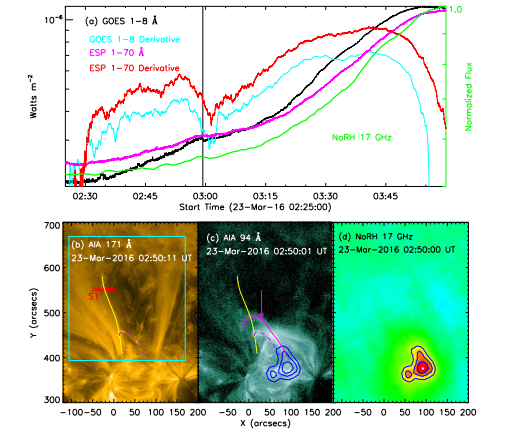Quasi-periodic pulsation (QPP) is a common oscillatory feature during the solar flare. However, the QPP in the coronal loop during the preflare phase is rarely reported. Here, we report the first observation of a QPP event, which is simultaneously detected from the spatial displacements of the coronal loop at both EUV images and microwave emission during the preflare phase of a C1.1 flare on 2016 March 23. Using the motion magnification technique (a-d), a low-amplitude transverse oscillation with the growing period is discovered in the EUV coronal loop in Atmospheric Imaging Assembly (AIA) image sequences at the wavelength of 171 ?, see the panel (d). The oscillation period is estimated to ~397 s with a growth rate of 0.045, and the oscillation amplitude is about 0.8 Mm, without significant damping. Then, a small-scale QPP with growing periods is discovered in the microwave flux at the same active region, and its period is estimated to increase from ~300 s to ~500 s, as shown by the green line in panel (c). Based on the imaging observations measured at EUV wavelengths by the AIA and at microwave 17 GHz by Nobeyama Radioheliograph (NoRH), the EUV diffuse coronal loop and microwave radiation source are found to be connected through a hot loop seen in AIA images at wavelength of 94 ?, suggesting that the loop oscillation and the microwave QPP may be triggered by the same thermal process, i.e., kink oscillations. The growing periods might be explained by the modulation of the LRC-circuit oscillating process in a current-carrying plasma loop. The existence of electric currents may imply the non-potentialities in the source region during the preflare phase.

By with LI Dong Figure 1. Top row: SXR light curves on 2016 March 23 in GOES 1–8 ? (black), ESP 1–70 ? (magenta), and their time derivatives, as well as the normalized flux at 17 GHz (green) integrated from the active region (panel (d)) measured by the NoRH. The black vertical line indicates the onset time of the solar flare. Bottom row: nearly simultaneous images (~320″ × 400″) recorded by SDO/AIA and NoRH. The cyan box outlines the FOV of the animation, and the two red lines mark the boundaries of slice (S1) used to plot the time–distance images. The yellow line marks part of the coronal loop, and the purple dashed line indicates a sheared arch, while the magenta line (or arrow) indicates a hot loop in AIA 94 ?. The blue contours represent the microwave emissions at the levels of 70%, 80%, 90%. An animation of panels (b) and (c) is available. The animation begins on 2016 March 23 02:30:11. This work has been published in the Astrophysical Journal Letters (2020, 893, L17), see: https://iopscience.iop.org/article/10.3847/2041-8213/ab830c |
